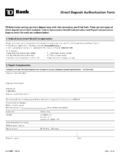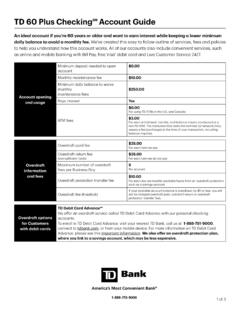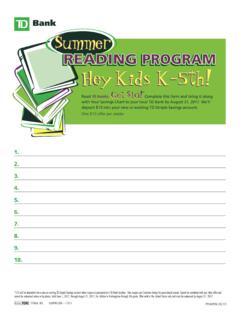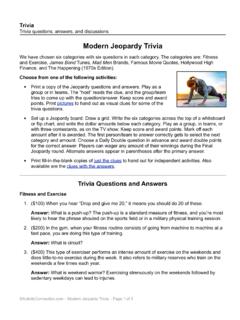Transcription of CHECK IT OUT! A LOOK AT CHECKS AND HOW TO KEEP A …
1 CHECK IT OUT! A LOOK AT CHECKS AND HOW TO KEEP A REGISTER. Key Concepts CHECK -writing, credits and debits, record-keeping Summary This lesson introduces the steps for writing CHECKS and maintaining CHECK registers Overview & Lesson Objectives This lesson is intended for elementary students in fourth and fifth grade. This lesson teaches students the parts of a CHECK , how to write a CHECK , and how to manage a CHECK register. Students will be able to: Write practice CHECKS Complete a practice CHECK register and describe its importance Distinguish between deposits/credits and payments/debits Time Allocation: 15 - 20 Minute Prep 35 - 40 Minutes Engagement Materials: Calculator Plain envelope Copies of Dollar Bills Copies DAMPER CHECK , Sample CHECK and Blank CHECK Register worksheet (one per student).
2 Copies of Blank CHECK worksheet (two per student). TD Bank Financial Education 1 Grades 4-5/Lesson 2. Lesson Begins: Setting the Stage Background Builder #1: Show students an envelope stuffed with play money. Elicit from students the dangers of sending large sums of cash (bills and coins) through the mail. Make sure that they understand that it could be stolen, expensive to mail if heavy, and impossible to reclaim if it gets lost. Ask students if they have ever received money in a card via the United States Postal Service. Ask if anyone has ever received a CHECK ? State the Objective: tell the students what they will be able to do upon conclusion of the lesson. At the end of this lesson, you will be able to write a CHECK and keep track of activity (deposits and debits) in a checking account.
3 Lesson Continues People can use a bank account to pay for goods and services. Paying by CHECK is a safe way to pay for things through mail because you give permission to only one company or one person to receive a specific amount of money. Explain the word DAMPER, the six parts of a CHECK . Distribute a copy of the DAMPER CHECK to each student and explain each part to the students. D Date The date the CHECK is issued A Amount This is the amount of money to be paid to Payee M Maker A signature of the person responsible for the amount shown above. P Payee This is the person getting the money written in the Amount Box. E Endorsement This is a signature of the person cashing or getting the amount in the box. R Routing Number Identifies the bank the CHECK belongs to.
4 Now it is time to practice writing a CHECK . Distribute a copy of a sample CHECK and blank CHECKS to each student. Instruct students how to fill out each part of a CHECK and the importance of being exact when writing a CHECK . Ideas for writing a sample CHECK : Pay to the order of a local gym or swimming pool for $250, regarding yearly membership. Pay to the order of a local retailer for $65 regarding a new pair of sneakers. Pay to the order of a local cable company or satellite provider for $75 regarding monthly service. Pay to the order of an Internet provider for $25 regarding monthly service. Pay to the order of a book club for $15 regarding books purchased. As students complete the blank CHECK worksheet, circulate throughout the class, complimenting students who are completing the work successfully, answering questions, and offering help to anyone who may require it.
5 TD Bank Financial Education 2 Grades 4-5/Lesson 2. Things can become disorganized if you do not keep track of your money and your CHECKS . When you open a checking account, you receive a CHECK register. This is the place to record every CHECK you write, every ATM withdrawal you make, and every deposit that you make. You will always know if you have enough money to pay for the CHECKS you have written, so that you don't overdraw your account and get into serious financial trouble. When you write a CHECK , you must subtract the amount you spent from your balance. A. deposit means you can add the amount to your balance. Careful arithmetic is very important! Proceed to discuss the aspects of an entry in a CHECK register <refer to CHECK register>: the CHECK number, the date it was written, the description of the CHECK /debit or deposit, the amount of the CHECK /debit or the deposit, and the balance forward.
6 Ask students to point to each part as it is described. Lesson Closes Review with students why people use CHECKS to pay bills ( safety, convenience) and the importance of keeping accurate records in the CHECK register. Review the difference between a deposit/credit and a payment/debit. See the suggestion page for Additional Engagement Opportunities/Resources , for additional ideas. Additional Engagement Opportunities / Resources Pair and Share Students (pairs) interview one another about the lesson content. They must summarize the partner's feedback in either written report or verbal format Sample Questions: How would a checking account be useful for you? Why is it important to keep a CHECK register? Would you expect to make more deposits or debits?
7 Student generated questions should also be encouraged in place of or in addition to the ones listed above. Quizbowl Separate the students into two or three teams and ask questions related to the lesson. Sample Questions: Who is the maker of a CHECK ? Who endorses the CHECK ? Why is a routing number important? Do you subtract or add when you've written a CHECK ? TD Bank Financial Education 3 Grades 4-5/Lesson 2. CHECK Register Worksheet Directions: Read the story about a brother and sister saving for a very special gift. Have the student's record the deposits, debits, and balance brought forward on their sample CHECK register. They may use a calculator to CHECK for accuracy. Be sure to CHECK all work. Money trivia The following are miscellaneous facts about money that you may wish to include in your presentation.
8 They may also be helpful in answering questions the students have: About 3,500 years ago Cowrie shells (small seashells) were used for money in China, Africa, and Australia. The Yap Islanders in the Pacific Ocean used large stone disks about 13 feet across for money. (This is about as long as a chalkboard.). China used bricks of tea leaves for money until just 100 years ago. The Roman soldiers earned their wages in an allowance of salt, called a salarium. This is where the word salary originates. Coins last about 20 or 30 years in circulation before they are worn out. $1, $5, $10, and $20 bills last about 3 months. Then they are shredded and burned by special people in the government. $50 and $100 bills can last for 3 or 4 years.
9 Do you know who is pictured on our currency? George Washington $1 - One Dollar Thomas Jefferson $2 Two Dollars Abraham Lincoln $5 Five Dollars Alexander Hamilton $10 Ten Dollars Andrew Jackson $20 Twenty Dollars Ulysses S. Grant $50 Fifty Dollars Benjamin Franklin $100 One Hundred Dollars William McKinley $500 Five Hundred Dollars TD Bank Financial Education 4 Grades 4-5/Lesson 2. Educational Standards National Council of Teachers of Mathematics Principles and Standards for School Mathematics, 2000. Number and Operations (Students will) Understand meanings of operations and how they relate to one another. Number and Operations (Students will) Compute fluently and make reasonable estimates. Communication (Students will) Organize and consolidate their mathematical thinking through communication.
10 Communication (Students will) Use the language of mathematics to express mathematical ideas precisely. Connections (Students will) Recognize and use connections among mathematical ideas. Representation (Students will) Create and use representations to organize, record, and communicate mathematical ideas. National Standards in K 12 Personal Finance Education (from Jump$tart Coalition) 2017: Spending and Saving Standard 2, Develop a system for keeping and using financial records.. TD Bank Financial Education 5 Grades 4-5/Lesson 2. CHECK Register Worksheet Name_____. A Very Special Gift Shakira and Josiah knew their grandparents would be celebrating 50 years of marriage very soon. A. party was being planned to celebrate the event.












